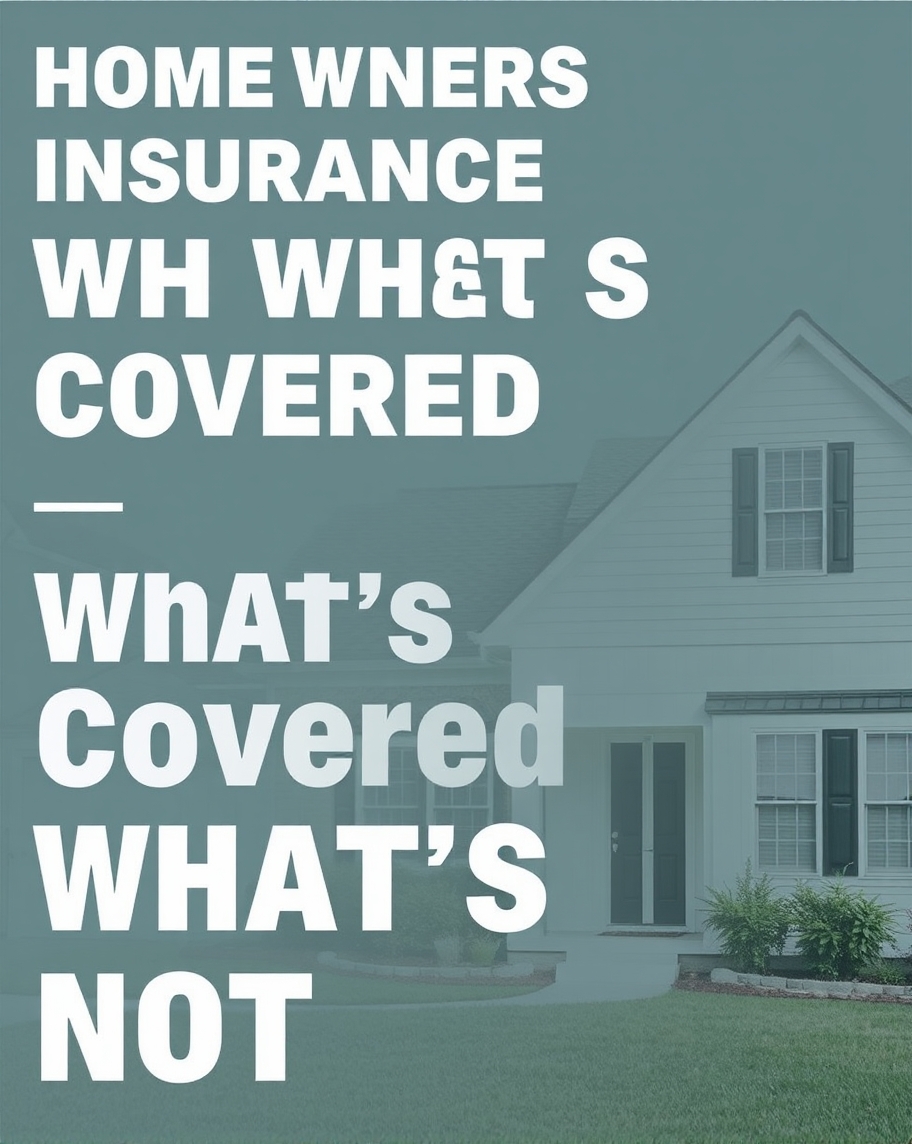Homeowners Insurance What’s Covered and What’s Not
Homeowners insurance provides financial protection for your home and personal belongings in the event of certain unexpected events. However, not everything is covered by a standard policy, and understanding the specifics of what’s included and what’s excluded can help homeowners avoid costly surprises. Here’s a comprehensive guide to what’s typically covered by homeowners insurance—and what’s not.
What’s Covered by Homeowners Insurance
Most standard homeowners insurance policies, also known as HO-3 policies, cover a range of risks under different categories:
1. Dwelling Coverage
This covers the structure of your home—including walls, roof, floors, and built-in appliances—against specific perils.
Commonly Covered Perils:
- Fire and smoke
- Lightning strikes
- Hail and windstorms
- Vandalism and theft
- Falling objects (e.g., tree branches)
- Damage from vehicles or aircraft
- Weight of ice, snow, or sleet
- Water damage from burst pipes
This part of your policy ensures that if your home is damaged or destroyed by a covered event, your insurer will pay to repair or rebuild it up to the policy limit.
2. Other Structures
This includes detached structures like garages, sheds, fences, and guesthouses. Typically, coverage for other structures is set at a percentage (usually 10%) of the dwelling coverage limit.
3. Personal Property
Homeowners insurance covers your personal belongings (furniture, clothing, electronics, etc.) both inside and outside your home, such as in your car or while traveling.
Covered Scenarios:
- Theft
- Vandalism
- Fire or smoke damage
- Certain weather-related events
Some policies provide replacement cost coverage (reimbursing you for the cost of replacing items) or actual cash value coverage (paying the depreciated value of the item).
4. Liability Protection
If someone is injured on your property or if you accidentally damage someone else’s property, liability coverage helps protect you from lawsuits.
Covers:
- Legal fees if you’re sued for injuries or property damage.
- Medical payments for injuries sustained by guests on your property, regardless of fault.
5. Additional Living Expenses (ALE)
If your home becomes uninhabitable due to a covered event (like a fire), ALE covers the cost of temporary housing, meals, and other living expenses while your home is being repaired or rebuilt.
What’s Not Covered by Homeowners Insurance
While homeowners insurance provides broad coverage, it does not cover every type of damage or disaster. Understanding the exclusions can help homeowners prepare for additional risks.
1. Flood Damage
Standard homeowners insurance does not cover flood damage, whether it’s caused by heavy rainfall, storm surges, or overflowing rivers. For flood coverage, homeowners must purchase a separate flood insurance policy through the National Flood Insurance Program (NFIP) or a private insurer.
2. Earthquakes and Earth Movements
Most homeowners policies exclude damage caused by earthquakes, landslides, and sinkholes. To protect against these events, you’ll need to purchase separate earthquake insurance.
3. Wear and Tear or Neglect
Homeowners insurance is designed to cover sudden, unexpected damage, not issues related to lack of maintenance, gradual wear and tear, or neglect. For example:
- Roof leaks from poor maintenance
- Pest infestations
- Mold growth due to unresolved water issues
Regular upkeep of your home is the homeowner’s responsibility.
4. Sewer Backup
Damage caused by sewer or drain backups is typically excluded from standard homeowners insurance. Homeowners can add an endorsement to their policy for additional protection against sewer and drain issues.
5. Certain High-Value Items
While personal property is generally covered, certain high-value items like jewelry, artwork, collectibles, and antiques may not be fully protected under a standard policy’s limits.
Solution:
- You can purchase additional coverage (an endorsement or rider) for high-value items to ensure they are fully insured for their appraised value.
6. Acts of War and Nuclear Hazards
Most policies exclude damage caused by acts of war or nuclear accidents. These are considered catastrophic events beyond the scope of homeowners insurance coverage.
7. Home-Based Businesses
If you run a business out of your home, standard homeowners insurance typically won’t cover business-related equipment or liability. You may need to purchase separate business insurance or add an endorsement for home-based businesses.
8. Government Action
Damage caused by government actions, such as the seizure of property or demolition orders, is typically excluded from homeowners insurance policies.
Additional Coverage Options (Endorsements)
Homeowners can customize their policies by adding endorsements to cover specific risks not included in standard policies. Common options include:
- Flood Insurance: Provides coverage for flood-related damage.
- Earthquake Insurance: Covers damage from earthquakes and earth movements.
- Sewer Backup Coverage: Protects against damage caused by sewer and drain backups.
- Scheduled Personal Property: Provides additional coverage for valuable items like jewelry, fine art, or collectibles.
- Green Home Coverage: Covers the cost of rebuilding with eco-friendly materials.
Conclusion
Homeowners insurance provides essential protection for your home, personal belongings, and liability risks, but it’s important to understand both the coverage limits and exclusions of your policy. For risks like floods, earthquakes, or sewer backups, additional insurance policies or endorsements may be necessary. To ensure that your coverage is adequate and that there are no surprises, regularly review your policy and discuss your needs with your insurance agent.
